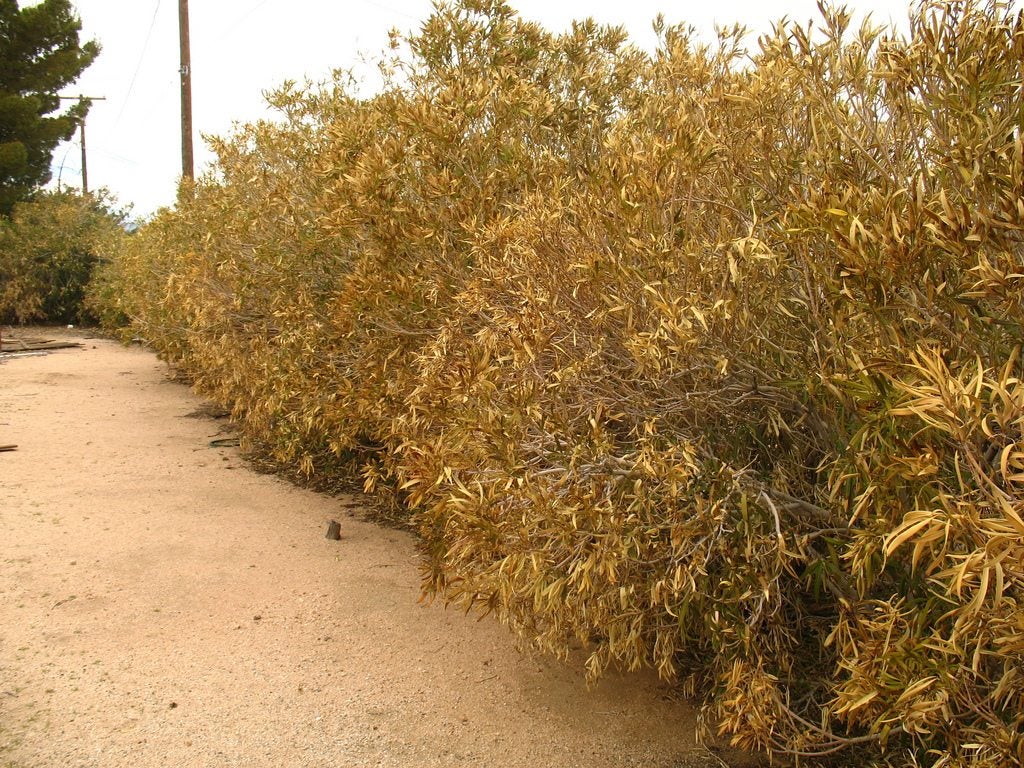Yellowing Oleander Bushes: Reasons For Oleander Leaves Turning Yellow


Oleander is a sturdy, attractive plant that grows happily with very little attention but, occasionally, problems with oleander plants may occur. If you notice oleander leaves turning yellow, the problem may be leaf scorch, a common cause of problems with oleander plants. Read on to learn more about leaf scorch and other problems that may cause yellowing oleander bushes.
Reasons for Oleander with Yellow Leaves
Treating yellow leaves on oleander starts with pinpointing a cause. Below are the most common reasons for leaf yellowing in oleanders.
Insufficient watering may lead to yellow leaves on oleander
Improper watering, either too much or too little, may be the cause for yellowing oleander bushes. Although oleanders are highly drought tolerant, they benefit from irrigation during long dry spells. However, too much water can harm the plant and may be to blame for an oleander with yellow leaves. If improper watering is the cause, the plant should soon rebound with proper irrigation. If problems with oleander plants continue, the problem is probably due to leaf scorch.
Leaf scorch and yellowing oleander bushes
Oleander leaf scorch was first discovered in southern California, where it quickly decimated oleander bushes. Since that time, the disease has spread to Arizona and is gradually overtaking oleander across much of the southern United States. Leaf scorch is a bacterial disease spread primarily by small, sap-sucking insects known as sharpshooters. The pests introduce the bacteria into the plant’s stem as they feed. When the bacteria grow in the plant’s tissues, flow of water and nutrients is blocked. Symptoms begin with oleander leaves turning yellow and droopy before taking on a scorched, brown appearance. The disease, which may begin on a single branch, spreads quickly in warm weather. The bad news is that the disease is fatal. So far, insecticides have proven to be ineffective and there are no cures for the disease. All varieties of oleander are equally susceptible, and no disease-resistant strains have been developed. Unfortunately, the only recourse for oleander with leaf scorch is to remove the affected plants. Pruning out damaged growth may temporarily slow the disease and improve the appearance of the plant, but in spite of all your best efforts, death usually occurs in three to five years.
Gardening tips, videos, info and more delivered right to your inbox!
Sign up for the Gardening Know How newsletter today and receive a free copy of our e-book "How to Grow Delicious Tomatoes".

A Credentialed Garden Writer, Mary H. Dyer was with Gardening Know How in the very beginning, publishing articles as early as 2007.
-
 Zinnias On Repeat: 10 Glorious Cut-And-Come-Again Varieties For Endless Summer Bouquets
Zinnias On Repeat: 10 Glorious Cut-And-Come-Again Varieties For Endless Summer BouquetsThese zinnia varieties keep giving all summer, making them the perfect choice for dedicated cutting gardens – or just the occasional homegrown bouquet.
By Ellen Wells
-
 Create A Romantic Garden Straight Out Of Bridgerton: Regency Era Romance In Your Garden
Create A Romantic Garden Straight Out Of Bridgerton: Regency Era Romance In Your GardenTry some romantic garden ideas straight out of Bridgerton. Flowers and gardens in the Regency era were lush and charming and you can get the same look!
By Bonnie L. Grant